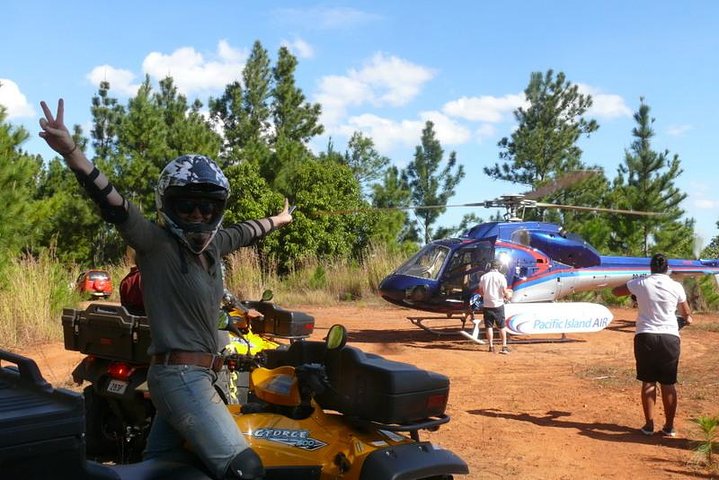From Mud to Mountaintops: The ATV-and-Heli Combo Out of Nadi
Ride rough trails, visit an authentic village, and fly home with island views—an adrenaline-and-culture half-day out of Nadi.
You feel the first judder through the handlebars before you see the view: a grit-slick track unspools between cane fields, then tilts up into a pine-scented slope. The quad surges, tires flinging sugarcane dust, and the island of Viti Levu rearranges itself behind you—flat lowlands giving way to a green shoulder of ridgeline, the Mamanuca Islands glittering like a memory on the horizon. The ride is short, sharp, tactile: mud that dares you into a grin, a creek that negotiates your line, the press-and-release rhythm of throttle and brake.
Trail Wisdom
Book morning slots
Mornings generally have steadier weather and clearer views for the helicopter segment.
Wear closed-toe shoes
Sturdy trail runners or light hiking boots protect feet on muddy, rocky sections.
Bring small gifts for the village
Practical items like pencils or notebooks are more useful than candy—ask your guide for guidance.
Protect your camera gear
Rotor wash is real—use straps and weather protection to keep lenses clean and secure.
Local Knowledge
Hidden Gems
- •A small ridgeline viewpoint beyond the main plateau that has unobstructed Mamanuca views
- •The nearby Nadi Market for local fruits and handcrafts after your tour
Wildlife
Fijian long-tailed fruit bats (flying foxes), Tropical forest birds such as the Fiji parrotfinch
Conservation Note
Tours support local economies—travelers should pack out waste, avoid single-use plastics, and ask before photographing children or private homes.
The route skirts communities shaped by Fiji’s sugarcane industry and Indian-Fijian migration; the Sri Siva Subramaniya Temple in Nadi reflects a long-standing Hindu presence.
Seasonal Guide
spring
Best for: Greener ridges, Fewer tourists
Challenges: Intermittent showers, Mud on lower tracks
Spring (Sep–Nov) bridges dry and wet seasons—trails are green but can get muddy; book flexible slots.
summer
Best for: Lush landscapes, Dynamic skies for heli shots
Challenges: Wet-season rainstorms, Potentially heavier mud puddles
Summer (Dec–Feb) is wetter—mud puddles are at their most dramatic and some sections may be slippery.
fall
Best for: Dry trails, Clear helicopter views
Challenges: Shorter daylight in late season, Occasional trade winds
Fall (Mar–May) tends toward the drier side with good flying conditions and solid off-road footing.
winter
Best for: Stable weather, Best visibility for aerial views
Challenges: Cooler mornings in the mountains, Higher demand from visitors
Winter (Jun–Aug) is Fiji’s dry season—ideal for quads and heli flights with crisp light and limited rain.
Photographer's Notes
What to Bring
Sturdy trail shoesEssential
Protects feet and provides traction on muddy and rocky tracks.
Light rain shell
Compact protection during sudden tropical showers—useful in the wet season.
Sunglasses with strapEssential
Reduces glare during the heli flight and keeps eyes clear from dust on the trail.
Small daypack with waterEssential
Carry water, sunscreen, and a few snacks—guides provide light refreshments but you’ll want personal access.
Common Questions
How long is the ATV and helicopter experience?
The tour runs about 3 to 4 hours from pick-up to return and includes off-road riding, a village visit, and the helicopter leg.
Is prior ATV experience required?
No—guides provide instruction and the route is suitable for beginners, though basic comfort with handling a quad helps.
Can children join the tour?
Age and weight limits vary—check with the operator, but most companies restrict solo driving to older children and require child seats or passengers for younger riders.
Are village visits staged for tourists?
This particular tour emphasizes authentic visits; your guide will explain local customs and any photography etiquette required by residents.
What happens in bad weather?
Helicopter flights are weather-dependent; the operator will reschedule or refund for significant weather cancellations as per booking terms.
Are refreshments provided?
Light snacks are included on the mountain plateau; it’s wise to carry a bottle of water for the ride.
What to Pack
Sunglasses (reduce glare and dust), Water bottle (stay hydrated in the tropics), Small cash/gifts (for village purchases and school supplies), Light rain shell (sudden showers possible)
Did You Know
The Sri Siva Subramaniya Temple in Nadi is among the largest Hindu temples in the Southern Hemisphere, reflecting the island’s significant Indo-Fijian community.
Quick Travel Tips
Closest airport: Nadi International Airport; Expect about 20–45 minutes drive to trail start depending on traffic; Cell service can be spotty on mountain ridges—download maps offline; Bring sunscreen and mosquito repellent
Local Flavor
After the ride, head to Port Denarau or the Nadi Market for fresh kokoda (Fijian ceviche), grilled seafood, and cold local beers—both spots are good for meeting locals and sampling island flavors.
Logistics Snapshot
Closest airport / trailhead: Nadi International Airport; Driving distance from Nadi town: 20–45 minutes depending on exact departure point; Cell service: intermittent on mountain plateaus; Permits/passes: none required—tour is fully booked and operated with local permissions
Sustainability Note
This experience engages remote villages—respect local customs, avoid single-use plastics, and consider bringing practical school supplies to donate through your guide rather than candy.

